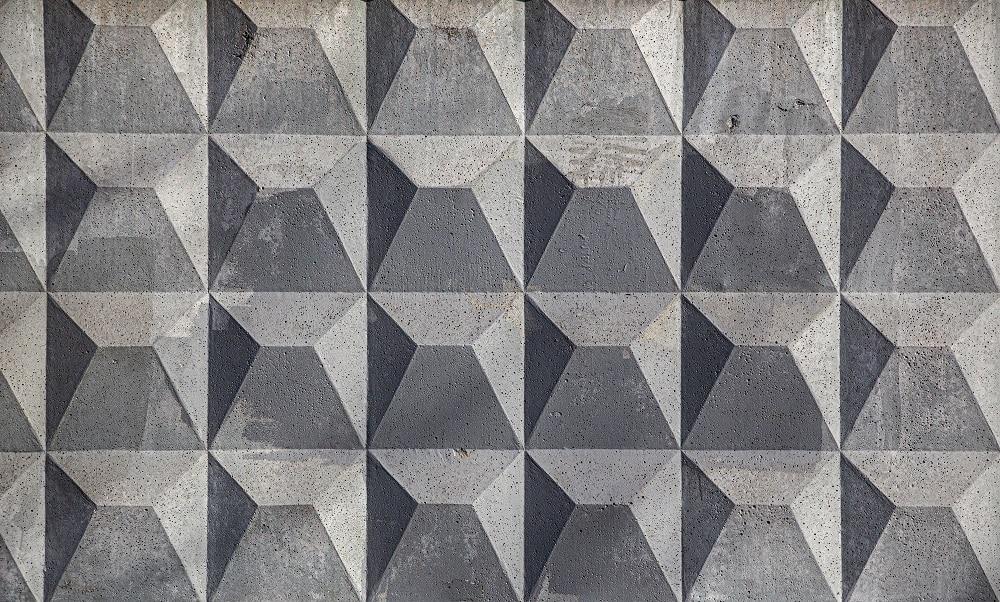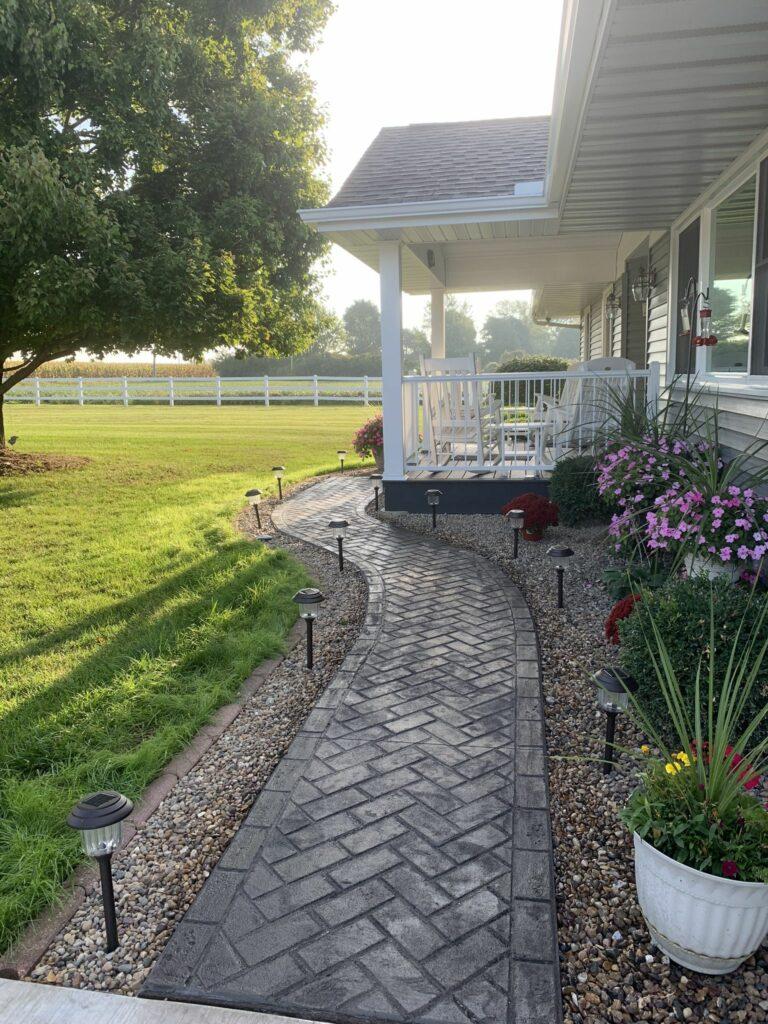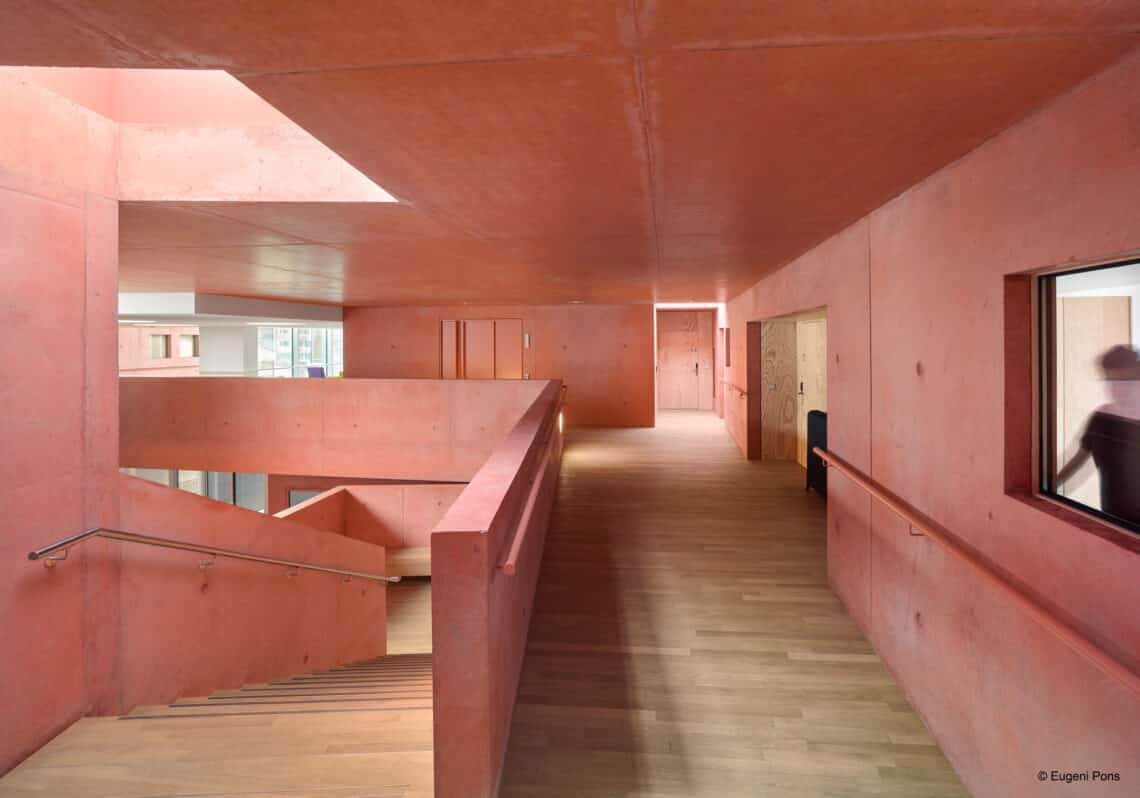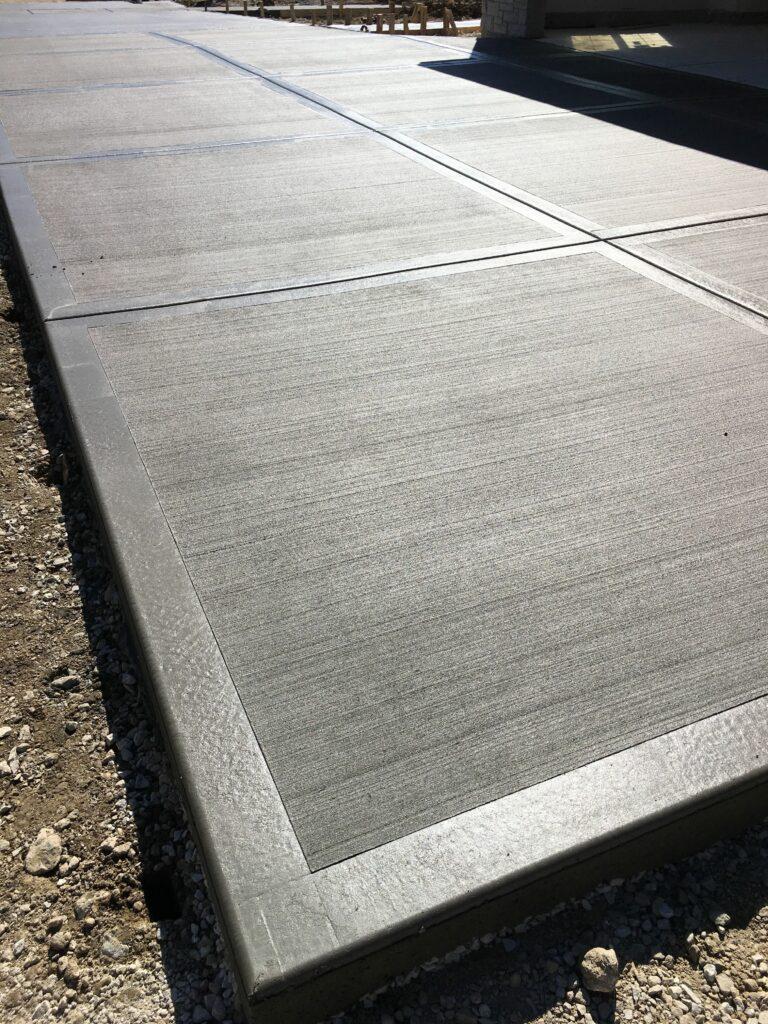A colored concrete porch by the swimming pool or a concrete finish driveway can instantly make your property look like a million bucks!
Concrete is one of the most versatile and customizable materials, which offers durability and an aesthetically pleasing appearance. Hence, it is no surprise to see it as a popular pick among most homeowners for outdoor applications.
However, the most basic design for a concrete surface includes trowels and screeds. But basic is not what you want, and we understand! So, here’s a list of ten attractive and long-lasting types of concrete finishes for residential, commercial, and industrial areas alike.

1. Stamped Concrete Finish

Concrete stamps are something you may spot in most public places like walkways, driveways, car porches, and more. The concrete stamp is a panel, sometimes sporting a motif, pressed on concrete while still curing.
As a result, the concrete floor retains its texture and may look like slates, bricks, tiles, or even wood. The surface can further be colored for an even more attractive and unique look.
Overall, the stamped concrete finish is an innovative way of adding some designs and textures to your surrounding environment.
2. Pigments Concrete Finish

Photo Courtesy of Eugeni Pons
As the name suggests, this type of concrete finish requires one to pour the pigments directly into the concrete mix. Needless to say, this step should be done before pouring the concrete on the desired surface.
Note that you may find pigments in liquid form and powdered form (as “ready to mix” dissolvable packets). So, make sure you choose one according to your preference and convenience. In both cases, though, you will have to combine the pigments with the concrete.
The only downside of such concrete pigments is that the color options are limited to neutral, “earthy” tones like browns, grays, greens, and blues. Plus, you must prepare just the right amount of pigment, as storing them without a seal may shorten the shelf life.
The good thing is that you can finish the surface through any means, and the color will be there. Whether you go for polished concrete, swirl concrete finish, or anything else, the design will be coherent throughout, offering architects and designers great flexibility.
3. Salt Finish

A salt finish concrete surface can be achieved by sprinkling coarse rock salt crystals on wet, fine-level concrete. Once the concrete mix is adequately dry, rinse away the salt particles. This will result in a rough, subtle texture that offers excellent skid resistance, thereby making this concrete finish suitable for swimming pools and the surrounding wet areas.
Additionally, we think this type of concrete surface will suit a porch with rustic decor pieces!
4. Concrete Stain

If you want a stylish and smooth surface but nothing too in-your-face, try the concrete stain finish. To create this type of concrete surface, various staining agents can be used to change the color of the concrete. You can choose from neon shades and neutral tones or incorporate water-based acrylic stains to create more colors.
Though you can apply the stains to fully cured concrete too, adding them right after the concrete is laid ensures intense color payoff. Once the stains are applied, they should be followed by a sealant to ensure a smooth surface and make the colors last long.
5. Colored Concrete Finish

Colored, pigmented, stained- while these types of concrete finishes sound similar, the process and result of each are widely different.
For a colored finish, the desired color is mixed with concrete in the form of post-cure staining or pigments. Here, too, the pigment must be added to the concrete mixture directly before pouring.
However, unlike the previously mentioned concrete finishes, a colored finish is much more saturated, and you get more variety of colors to choose from.
6. Swirl Concrete Finish

This type of design is perfect for those who want a subtle yet aesthetically pleasing appearance on their concrete surface. To achieve the swirls, the concrete surface is smeared in an evenly overlapping circular motion.
Interestingly, this finish not only ensures a stylish look to your surroundings but also offers more friction to the otherwise smooth surface. As such, this concrete surface becomes much safer to walk on, especially in the wet season.
7. Broom Concrete Finish

Similar to the previously mentioned swirl finish, the broom finish is created by swiping a broom across the wet concrete surface. However, keep in mind that the concrete must be level and troweled.
The design features extremely narrow ridges, which offer skid resistance to the floor. Hence, if you have a concrete surface surrounding the pool or any wet surfaces, getting a broom finish would be a good idea!
8. Polished Surface Concrete Finish

Polishing requires a mechanical process of grinding the concrete surface with specialized tools and penetrant chemicals. Most floor grinders contain heavy-duty diamond abrasives, making them rigid enough for polishing plain surfaces.
On completion, polished concrete will have a shiny, smooth surface desired in various public spaces like malls, museums, and more. However, because of its smooth texture, this type of concrete finish can get slippery and dangerous near wet areas.
9. Exposed Aggregate Finish

If you dig the vintage aesthetic, this concrete design is the perfect pick for your house! Basically, the exposed aggregate finish is achieved by washing away the top layer of the cement once it is leveled and trowelled. Consequently, the aggregates become exposed, revealing a rough slip-resistant texture.
Further, you can add different materials like crystals, seashells, tinted glasses, etc., to the usual mixture of cement, gravel, sand, and water. But ensure that you don’t include any iron-containing materials as they may discolor with time.
Moreover, to make the exposed aggregate finish last long, you must use a high-quality sealant once the concrete has fully cured.
10. Floating or Troweling Concrete Finish

Once the concrete is tooled, concrete finishers use trowels to fine-level the concrete surface. Trowels can be used manually or mechanically, though power trowels are more convenient for large industrial and commercial projects.
Further, power trowels are available in riding and walk-behind variants, and both feature huge blades that look like big fans.
1. What kind of concrete surface will be the most suitable for roof slabs?
Usually, concrete finishers suggest troweling for roof slabs. However, the finishing is kept slightly rough for better adhesion to the following layers like waterproofing or flooring.
2. What is the purpose of “finishing” the concrete surface?
Finishing the concrete surface is essential for achieving a smooth and even layer, increasing its resistance to wear and tear, and keeping the designs intact.
3. What types of concrete finishes are suitable for common construction applications?
As already mentioned earlier, a trowel finish is the most suitable for roof slabs and commercial areas in general. Thereafter, a salt finish or any other slip-resistant concrete application is preferred for swimming pools and other wet areas.
Moreover, driveways, patios, and sidewalks require a stamped finish to offer adequate friction while looking unique and attractive. However, in different public settings, like museums, galleries, and auditoriums, a smooth polished concrete finish is desired.
Lastly, for play areas, parks, and gardens, colored concrete is the most popular selection.
4. What are some inexpensive ways of finishing a concrete surface?
You can DIY the concrete surface if you’re trying to save some bucks! However, a bit of planning and preparation beforehand goes a long way in ensuring you end up with a decent result.
Speaking of cheaper alternatives to finishing concrete, you could always lay a carpet over it to hide any uneven or slightly damaged parts. Other than that, epoxy kits are quite affordable and easy to use for first-time DIYers.
However, we wouldn’t recommend finishing a large area all by yourself. In case of any discrepancies, you could end up with significant structural damage. Hence, it is better to stick to your basement or garage floors for DIYs and opt for professional concrete finishers for other areas.
5. What are some flooring options for concrete surfaces?
The first pick for flooring over concrete is engineered wood. Not only does it add a warm and homey touch to your abode, but it also offers rigidity and moisture resistance, unlike natural wood. So, even though it is one of the most expensive materials for flooring, its durability makes it worth every penny.
Another option is vinyl, available in two forms, namely luxury vinyl planks and vinyl sheets. The material is highly water-resistant and, thus, suitable for bathrooms and kitchens. Moreover, if you live in colder regions, vinyl is an excellent choice for preventing cold transfer from the concrete.
However, if you have pets in the house or you work with tools, vinyl may not be suitable as it tends to scratch easily.
6. What are the best concrete sealers?
Epoxy or acrylic film-forming sealers are common for indoor use. However, since epoxy concrete sealers are more durable, you can incorporate those in high-traffic areas.
Other areas can make do with softer acrylic sealers. Also, keep in mind that water-based concrete sealers should be used indoors as they do not emit any toxic fumes.
Colored finish, salt finish, broom finish- with so many types of concrete finishes, we bet you were able to find the right one for your space. Just make sure you know the process, materials incorporated, pros and cons, and maintenance requirements of each, before making up your mind.
That said, we’ve reached the end of this informative guide. Stay tuned for more such articles, and we’ll be back soon.


